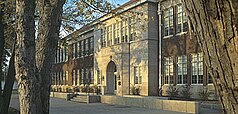Brown v. Board of Education National Historic Site
| Brown v. Board of Education National Historic Site | ||
|---|---|---|
| Monroe Elementary School, Topeka, Kansas | ||
|
|
||
| Location: | Kansas , United States | |
| Specialty: | Elementary school where segregation of students was challenged | |
| Next city: | Topeka | |
| Surface: | 0.8 ha | |
| Founding: | October 26, 1992 | |
| Visitors: | 18,400 (2005) | |
| School entrance | ||
The Brown v. Board of Education National Historic Site is a memorial of the type of a National Historic Site of United States . It was established by the United States Congress on October 26, 1992 in Topeka , Kansas , to refer to the Brown v. Board of Education of the Supreme Court to remember. The decision ended racial segregation in the US public school system. On May 17, 1954, the Supreme Court ruled that separate classes were illegal and, in particular, violated the 14th Amendment to the Constitution. This addition guarantees all citizens "equal protection from the law".
The area includes the Monroe Elementary School , one of the four primary schools for the black population in Topeka, and adjacent properties.
History of the place
The story of the Monroe Elementary begins in 1856 when the abolitionist John Ritchie bought an area of about 65 hectares in Topeka. After the American Civil War , some now freed former slaves came to the city and built their houses here. Due to the growing black population, the school board decided to build a school for black children. Ritchie's was chosen as the reason. It was only after Ritchie's death in 1877 that his land was bought by the school board.
The current building is the third school building on the site at the intersection between Finfteenth street and Monroe street . The first school was in a small rented building and was in use until 1868. A permanent building was erected in 1874. Finally, in 1926, the current building was erected, just south of the old building. Like many other schools, it was designed by the city's famous architect, Thomas W. Williamson. His company, Williamson and Co. , was hired by the school board to build a number of advanced schools. Monroe Elementary School is a two story brick and limestone building in the style of the Italian Renaissance. The most modern materials available at the time were used in the construction.
In a 2004 television interview for PBS, Barbara Ross, a former teacher at the school, recalls:
“I think they were good schools. They had qualified black teachers […] very qualified. Many people […] well, I say some people […] thought that the furnishings, equipment and other materials in the school could not compete with those in 'white' schools just because they were older buildings. They had the same books and we heard a lot about them. But they had the same books as others because there were a lot of black teachers on the committees that selected the textbooks - the textbooks. So we knew they had the same books. It is true - everything was not okay because the conditions in the community were not okay. We had nowhere to eat. We couldn't go to the theater and sit anywhere. We couldn't live in an apartment or in a motel; we had to live with a black family when we came here to teach. "
Monroe was the newest of the schools for black students in Topeka. The other schools were Buchanan , McKinley, and Washington . Washington no longer exists and the other buildings are no longer owned by the school board.
Use during the 1950s
Monroe originally had thirteen classrooms. From the time it was built until 1941, the building housed classes from kindergarten through eighth grade. Then the three upper school classes were transferred to the junior high schools , which created more space in the school building. The training room was later used as a canteen, two of the classrooms were adapted as classrooms for music and visual lessons.
A plot of land on the opposite side of the street was used as a playground and sports field. There were about softball , baseball , track and field and football teaches. Playgrounds existed on the north and south sides of the building.
Changing owners
The school was closed in 1975 due to declining student numbers. The building was first used as a warehouse, the parking lot was used for parking and servicing the school buses. Eventually the school and the land were sold to private individuals and remained there for 15 years. Richard Appelhans and Richard L. Plush, Jr. planned to convert the building into an office block or a private school, but sold it in 1982. The new owner was the Church of the Nazarenes , which used the building as a community center. In May 1987 the place was awarded the status of a National Historic Landmark under the name Sumner Elementary School / Monroe Elementary School . In 1988 the building was sold to Mark A. Steuve and used as a warehouse again. In 1990 he announced that he wanted to sell the building.
The Brown Foundation tried to prevent the school from being sold. After a series of letter campaigns and meetings with politicians and the Trust for Public Land , the school was saved. The Trust bought the school in 1991. On October 26, 1992 then-President George HW Bush approved the Brown v. Board of Education National Historic Site . In 1993 the National Park Service was commissioned to supply the site.
Web links
- National Park Service: Brown v. Board of Education National Historic Site (official site; English)
Individual evidence
- ↑ Listing of National Historic Landmarks by State: Kansas. National Park Service , accessed August 3, 2019.


